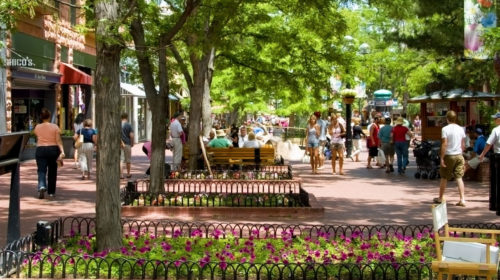Boulder, Colorado, USA - August 5, 2007: Shoppers in the Pearl Street Mall in Boulder Colorado on a beautiful summer morning.

Door-to-Downtown: How Boulder, Colorado, Tested the Future of Mobility
Rocky Mountain Institute recently published a report on Boulder, Colorado’s Door-to-Downtown mobility pilot. This report details the rationale, design, operation, and results of the pilot, which offered door-to-door mobility service to downtown Boulder.
Click here to download the report.
Boulder, Colorado, like many cities around the United States, faces a growing challenge. Urbanization has revitalized city centers, but it comes with a price—increased difficulty accessing the very amenities that are drawing folks downtown. As parking becomes increasingly scarce and traffic seemingly grows exponentially, how does a city maintain and improve access? Building more infrastructure (e.g., parking and roads) is expensive and consumes real estate that could be put to better use, and ultimately demand for private vehicle infrastructure grows faster than municipalities can build it. Rapid changes have created three principal opportunities that make a new mobility paradigm possible—Mobility as a Service (MaaS); electric, autonomous vehicles (EAVs); and mobility-oriented development (MOD). Private companies and cities alike are already moving toward a future where private vehicle ownership is no longer the default, as outlined in RMI’s Peak Car Ownership report.
Because of these myriad factors, Boulder chose to take a bold step toward the future and improve access to downtown without building a single parking space or adding a single lane-mile of road. Door-to-Downtown, or d2d, as it was popularly known in the community, was created as a true public–private partnership and offered local residents the opportunity to travel to and from downtown using door-to-door mobility services at a price that was competitive with driving and parking their personal vehicles. This price point is important because, according to recent research by Rocky Mountain Institute, door-to-door service prices will fall over the next several years and become much more competitive with private vehicle use. As a result, Boulder tested the demand and effectiveness of tomorrow’s mobility system, today.
Over the course of the 11-week program, registrants totaled more than 6 percent of Boulder’s adult population, and took nearly 2,500 inbound trips. This initial pilot, designed to bring retail and restaurant patrons downtown, provides invaluable lessons learned when designing future mobility programs that aim to serve ever-larger customer segments. Opportunities exist for downtown commuting as well as commuting and retail passengers in other areas of Boulder. Additionally, electric vehicles could be integrated into the system, and they could possibly even be powered by locally generated renewable energy.
This type of work is not just limited to Boulder; RMI is currently engaged with the city of Austin to expand mobility options across the city. Improving data sharing, creating public–private partnerships, and determining how and why citizens use alternatives to private vehicles are key to creating a more sustainable mobility future. The work in Boulder helps build this suite of information and creates opportunities across the country.
The future of mobility is just around the corner, and d2d is an excellent example of how communities can prepare for that future today, while avoiding expensive investments that may well be outdated long before the end of their useful life. As urban cores continue to attract businesses, residents, and visitors, access will be an increasing challenge. Finding innovative solutions that preserve the very amenities driving that vitality will create a virtuous cycle and drive economic vitality for decades to come.
